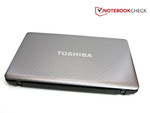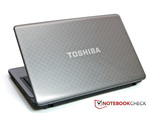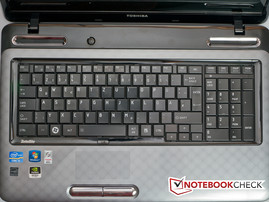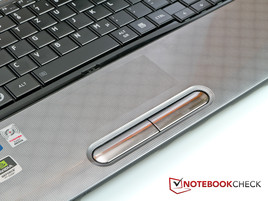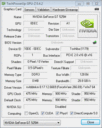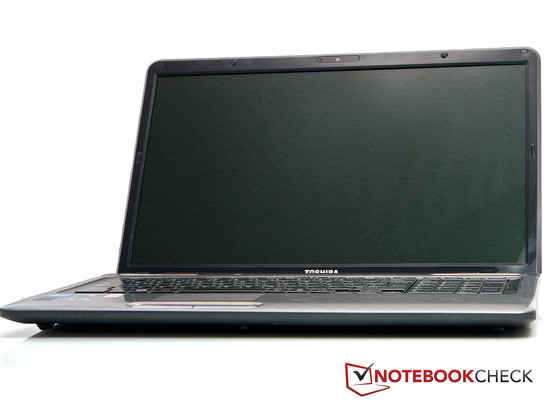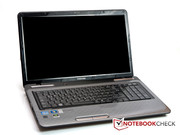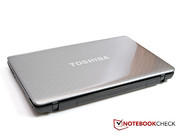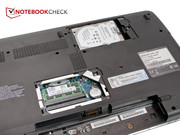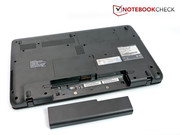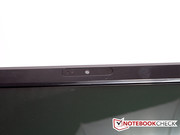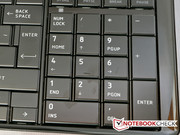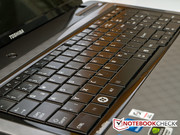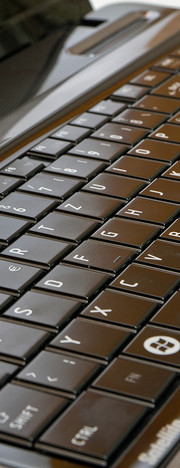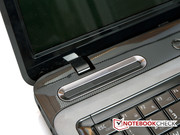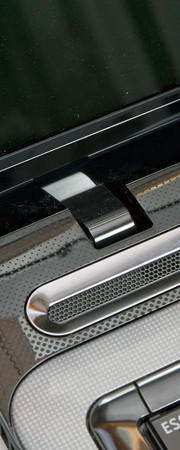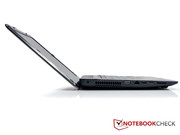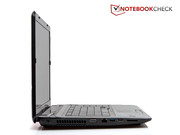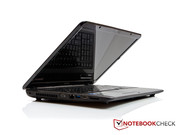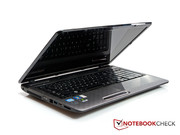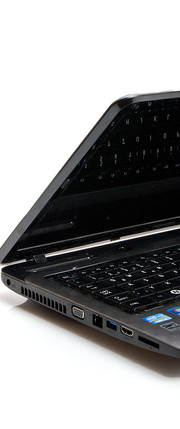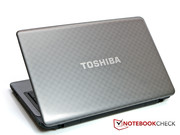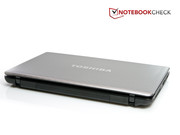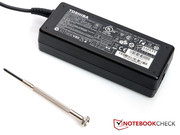Review Toshiba Satellite L775-125 Notebook

Toshiba launches a big 17 inch multimedia laptop onto the market called Satellite L775-125. In particular, the Satellite L775-125's big display makes it interesting as a desktop replacement (DTR). The hardware, consisting of a current processor of Intel's Sandy Bridge family and an Nvidia GeForce midrange graphics card, doesn't make this application field seem so farfetched, either. The big 500 GB hard disk should suffice most users for the time being, and the 4 GB of RAM should supply good performance.
We'd like to illustrate in which fields the Toshiba Satellite L775-125 laptop really excels in this review.
Case
The Toshiba Satellite L775-125 shows up in a rather plain gray. A pattern is used on the laptop's display lid that strongly reminds of a few suits (Toshiba calls this look Matrix Pattern). Toshiba's logo emblazons the display lid's center. Although Toshiba uses a glossy plastic surface, it is amazingly resistant against fingerprints. Most handlings don't leave any marks on the notebook's surface. Only dust is apparently attracted by the surface. A visible layer of dust quickly accumulates when the laptop is left closed on the desk for a while. When the notebook is opened, which is just still possible with only one hand, you'll see even more high-gloss surfaces. The hinges aren't pulled excessively tight. Thus, it can't be prevented that the big display teeters. Toshiba has implemented the design consistently and the gray is also found inside along with the pattern. We didn't find any visible fingerprints on the wrist-rest even after longer use.
As to workmanship, the laptop basically makes a good impression. Although the big display isn't particularly rigid and the display lid can be depressed easily, the overall manufacturing of the parts is acceptable. There aren't any creaking noises when pressure is applied. The wrist-rest could hardly be more solid. It doesn't yield even a millimeter even under high pressure. The keyboard is also quite stable. Only the number pad, directly above the optical drive, can be depressed a bit by selective pressure. The further you move away from the notebook's right edge, the less the keyboard yields.
The Toshiba Satellite 775-125 notebook has two covers on the bottom. You can access the hard disk and RAM slots after removing a few screws.
Connectivity
Although the Toshiba Satellite is a big 17 inch laptop, it hasn't exactly been generously equipped with interfaces. Thus, it only has three USB ports. This array is comprised of two USB 2.0 ports and a new USB 3.0 port. Interfaces like eSATA or an ExpressCard slot haven't been installed, either. The Toshiba Satellite L775-125's connectivity is sooner comparable with that of a 15 inch notebook.
Moreover, Toshiba has placed the majority of ports on the laptop's front area. While only both audio sockets and two USB ports are found on the right's very far front edge, almost all ports are in the front area on the left. This can result in a cable mess. In particular when the laptop has a stationary place, which isn't uncommon for a 17 inch notebook.
Communication
The Toshiba Satellite L775-125 basically has everything that you could want here. A Realtek PCIe GBE Family Adapter, which should provide enough speed thanks to Gigabit Ethernet, takes care of wired connections. A RTL8188CE Wireless LAN 802.11 card, also from Realtek, takes care of wireless connections. Bluetooth 3.0+HS completes the Toshiba Satellite L775-125's communication media.
Scope of Delivery
Unfortunately, the scope of delivery is very meager, as is the case for most laptops. Apart from the notebook, the battery and the adapter including power cable, there is only a bit of documentation in the laptop's box.
Warranty
Toshiba grants a 2 year warranty period on the Satellite L775-125. It includes Europe, the Middle East and Africa. Additionally, Toshiba grants a free onsite pick-up service within Germany and Austria. However, the repair has to be registered at Toshiba's notebook hotline.
Input Devices
Keyboard
Toshiba doesn't install a keyboard model with free-standing keys. A rather traditional design is used instead. The single keys have a size of 19x19 millimeters and thus are agreeably big (desktop standard). However, the real surface is a bit smaller because the keys have been beveled on the left and right. Consequently, about one millimeter is lost on the sides. This enlarges the key gap though, which is beneficial for accuracy and prevents typos. Thanks to the 17 inch case, Toshiba was able to install a number pad in the Satellite L775-125 despite the large keys.
The keys have a matt, but smooth surface. In contrast to the case's plastic surface, fingerprints remain clearly visible here. The black plastic bezel that frames the keyboard is also susceptible for fingerprints.
You first have to get used to the keyboard's typing feel. The key drop is normal compared to other notebook keyboards, so not excessively long or too short. However, the stop is a bit hard, which is tiring in our opinion because the keys have to be pressed with more force. But, subjectively, every user responds differently to various little points. It would make sense to try out the keyboard before buying.
Touchpad
The touchpad has been built directly into the wrist-rest. Only a small, corrugated field marks the touchpad. It has a diagonal of 92 millimeters. In other words, it has a width of 82 millimeters and a height of 42 millimeters. We found that particularly the height has turned out a bit small. 42 millimeters aren't very much and lets the touchpad look very narrow. In comparison, the touchpad in a 15 inch MacBook Pro has a height of 77 millimeters. Apart from the low height, you can work comfortably on the touchpad. You notice immediately if you are still on the touchpad or not, due to the roughened surface. The touchpad usually responded reliably and accurately in the test. It has multi-touch support as well as a vertical scroll bar. There is a small button in the black keyboard bezel above the touchpad which disables the touchpad completely, for example, when an external mouse is to be connected.
Both mouse keys are located below the touchpad in a small hollow. They are made of plastic and have been given a kind of chrome finish. Consequently, fingerprints are extremely well visible on both mouse keys. It is strange that components which are touched most by the user are prone to fingerprints. But both mouse keys don't exactly excel in terms of workmanship, either. The chrome finished plastic doesn't look as high-end as the rest of the case. Moreover, the keys can be pressed considerably deeper on their outsides than in the center. A clearly audible click from the keys provides feedback about triggering.
Display
The Toshiba Satellite L775-125 laptop has a big 17.3 inch display with HD+ resolution (1600x900 pixels). The screen's aspect ratio is 16:9 and is therefore very suitable for movies, which would also be legitimate due to the screen's size. Toshiba uses a screen with a glossy surface from Samsung. It is also possible to display the screen's content on a projector or a big TV in the living room thanks to the HDMI port.
| |||||||||||||||||||||||||
Brightness Distribution: 88 %
Center on Battery: 239 cd/m²
Contrast: 167:1 (Black: 1.43 cd/m²)
57.4% AdobeRGB 1998 (Argyll 3D)
77.9% sRGB (Argyll 3D)
56.3% Display P3 (Argyll 3D)
The display has an LED backlight that provides good brightness rates and a good illumination. All brightness rates are over 200 cd/m2 and are averagely 224.7 cd/m2. The laptop can't claim a top position with that, but it supplies solid rates. The illumination of 88 percent is also agreeably even. In return, the high black value of 1.43 cd/m2 isn't as agreeable. A rate less than 1.0 cd/m2 should be aimed for here because not only dark scenes in games and movies suffer from a high black value (they often simply look gray), but also the contrast does. It isn't particularly high with 167:1. The display can't exactly score in terms of color reproduction, either. The sRGB color spectrum can be rendered for the most part, but not completely. The Adobe RGB color spectrum doesn't even come close to being covered. However, the comparison with the Adobe RGB color space is rather more of interest for users who work professionally with pictures and depend on a precise color reproduction.
The Toshiba Satellite L775-125's screen can't really convince outdoors. The low contrast and the reflective display make it difficult to see anything on the display in sunlight. You have to make a strenuous effort and that is tiring in the long run. It's better to sit in the shade with the laptop. The displayed contents' legibility improves with that.
In terms of viewing angles, the Toshiba Satellite L775-125's screen fares like most other laptop displays on the market. You can easily take a few steps to the side without the content being distorted when looking onto the screen from the front. Color deviations turn up quite late on the horizontal plane. The situation is different, however, when you look at the display from above or below at an angle. The screen's content quickly becomes illegible. The picture either inverts or fades.
Performance
The Intel Core i5-2410M, currently a very popular processor from the latest Intel Sandy Bridge generation, is installed into the Toshiba Satellite. Although the midrange dual core processor is preferably used in 15 inch notebooks, it nevertheless still bids enough power for most applications in 17 inch laptops. The processor is fast with its default clock rate of 2.3 GHz. In cases of performance bottlenecks Intel's Turbo Boost is enabled. The processor's clock rate can thus be increased without the user's intervention. The clock rate can be increased up to 2.9 GHz depending on the requirements and processor's cooling. 2.9 GHz are only reached when one core is loaded. The clock is only increased to 2.6 GHz when the power of both cores are needed. Additionally, the processor is quite modest in terms of cooling with a TDP of 35 watts. Thus, the Toshiba Satellite L775-125 shouldn't have any problems in cooling the processor.
Despite the fact that an Intel HD Graphics 3000 is incorporated into the processor, Toshiba relies solely on Nvidia's GeForce GT 525M graphics card with a 2048 MB DDR3 memory. Alike the processor, it is a midrange model that should be fully sufficient for the average user. The graphics card is based on the GF108 core and is very similar to the GT 425M. However, the GT 525M has slightly increased clock rates. Besides that, the graphics card is capable of DirectX 11 and OpenGL 4.0. In addition to Office, Internet and multimedia, the graphics card is also suitable for the occasional game. Although compromises have to be made in sophisticated games like Metro 2033, older games can be very well played in high quality settings.
We use the programs Cinebench R10 and R11.5 in the 64 bit version in order to check the processor's performance. The Toshiba Satellite L775-125 reaches a score of 4505.0 points in the Cinebench R10 single rendering (64bit) benchmark. Thus, it is in the upper third of our benchmark chart. It sooner belongs to the slower models in this exercise when compared to other laptops that use an Intel Core i5-2410M. For example, the Asus K53SV-SX121V notebook (2410M, GT 540M) belongs to the top models with a Core i5-2410M processor with 4649.0 points. The Medion Akoya P6631 (2410M, GT 540M) supplies a similar performance with 4494.0 points. The Toshiba laptop could catch up in the Cinebench R10 multi rendering (64bit) benchmark and is in the midfield with 9575.0 points. Models such as the Asus K73SV-TY032V (2410M, GT 540M) are in a similar range with 9659.0 points.
Unfortunately, the Cinebench R11.5 doesn't allow any precise conclusions because the rating is too approximate. The Toshiba Satellite L775-125 reaches a score of 2.6 points here and is thus on a par with most other notebooks that have a Core i5-2410M processor. There are only few exceptions that merely reach 2.5 points here.
Finally, it can be said that the Toshiba Satellite L775-125 delivers the expected performance. Toshiba hasn't completely exhausted the installed processor's performance to the last bit, but the notebook can place itself overall in the good midfield of comparable notebooks.
The benchmarks, PCMark Vantage and PCMark 7 take over the rating of the total system. The benchmarks assess the entire system and rate it accordingly. The Toshiba Satellite L775-125 notebook is in a midfield position in our benchmark chart with 6053.0 points in PCMark Vantage's total rating. It is among laptops such as Dell's Inspiron 17R Notebook (N7110) (2410M, GT 525M) with 6134.0 points and Toshiba's Satellite L755-14P notebook (2401M, HD Graphics 3000) with 5951.0 points. The Toshiba Satellite is sooner in the lower midfield in PCMark 7 (compared to other laptops that also have an Intel Core i5-2410M). The system performance is acceptable on the whole, but nothing special compared to other notebooks.
| PCMark Vantage Result | 6053 points | |
| PCMark 7 Score | 1816 points | |
Help | ||
As expected, the midrange graphics card, Nvidia GeForce GT 525M, places the laptop approximately in the center of our benchmark chart. 3DMark06 is used as the benchmark. The Toshiba Satellite L775-125 notebook reached 6681.0 points here. Thus, it is in the immediate range of Dell's Studio XPS 16 (P8600, HD 4670) that achieved 6704.0 points and thus even excels the Satellite L775-125 a bit. The Acer Aspire 7551G-N934G64Bn laptop (N930, HD 5650) are slightly below Toshiba's notebook with 6661.0 points. The Toshiba sooner belongs to the somewhat slower models compared to other laptops that use the Nvidia GeForce GT 525M. The score that the Toshiba notebook reached is marginally below average.
| 3DMark 03 Standard | 15888 points | |
| 3DMark 05 Standard | 12064 points | |
| 3DMark 06 Standard Score | 6681 points | |
| 3DMark 11 Performance | 737 points | |
Help | ||
Toshiba uses the Seagate ST9500325AS as the hard disk. It is a 2.5 inch model with 5400 rpm. The hard disk complies with the currents standard with a (gross) capacity of 500 GBs. The achieved rates aren't anything special, either. The average transfer rate of 63.1 MB/s and access speed of 19.2 milliseconds are rates that are easily achieved by other hard disks, too.
Gaming Verdict
We also checked the Toshiba Satellite L775-125's gaming capabilities in our test. Two games were used for this: StarCraft 2: Wings of Liberty and Call of Duty: Black Ops.
StarCraft 2 didn't give the Toshiba laptop a hard time in either lower quality levels. The Satellite L775-125 could also render the game smoothly in low and medium detail levels. It starts to get tight with the setting high. The game is just still smooth with 26 frames per second.
Call of Duty: Black Ops can't distress the Toshiba Satellite L775-125 in the detail levels we tested. The game runs throughout smoothly in the detail levels low to high.
More games with the Nvidia GeForce GT 525M graphics card can be looked up in our big notebook gaming performance comparison "Computer games on laptop graphic cards".
| low | med. | high | ultra | |
|---|---|---|---|---|
| StarCraft 2 (2010) | 161 | 31 | 26 | |
| Call of Duty: Black Ops (2010) | 53 | 36 | 32 |
Emissions
System Noise
As the majority of laptops on the market, the Toshiba Satellite L775-125 is quiet and inconspicuous when it's not put under much load. The noise level ranges from 32.3 dB (A) up to 32.8 dB (A) in idle. However, the fan runs permanently, but only rotates slowly and you won't hear more than a quiet whirr. The hard disk's noise of 32.5 dB (A) is drowned out by the cooling systems noise most of the time. It is only audible at times where a larger hard disk access takes place. The drive is a bit louder with 34.5 dB (A). The drive can get annoying when watching a movie and a quiet scene is played. The noise level climbs to 40.6 dB (A) - 42.0 dB (A) when the laptop is put under load. The notebook is now clearly audible and even the draft produced by the cooling system is audible.
Noise level
| Idle |
| 32.2 / 32.4 / 32.8 dB(A) |
| HDD |
| 32.5 dB(A) |
| DVD |
| 34.5 / dB(A) |
| Load |
| 40.6 / 42 dB(A) |
 | ||
30 dB silent 40 dB(A) audible 50 dB(A) loud |
||
min: | ||
Temperature
As expected, the temperatures in idle mode are harmless. A maximum of 24.8 degrees Celsius are measured on the top, whereas the wrist-rest reaches 28.2 degrees Celsius on the left and 27.3 degrees Celsius on the right. The touchpad heats up to 27.0 degrees Celsius. All rates are uncritical here.
It doesn't look much different on the bottom, either. The maximum temperature here is 31.0 degrees Celsius. Thus, the notebook can be placed on the lap without hesitation even when you're only wearing short pants.
The temperatures increase significantly during load. The top's maximum temperature is now a hot 49.8 degrees Celsius. The laptop reaches this rate in the upper left above the keyboard. The vent is also located here, which would explain the high temperature. The wrist-rest temperatures only increase slightly with 30.1 degrees Celsius (left) and 29.5 degrees Celsius (right). And the touchpad's temperature also increases only slightly to 28.6 degrees Celsius.
It's similar on the bottom. The hottest spot is found in the cooling system's air outlet vicinity with 51.8 degrees Celsius. Even if few users will use the laptop with full load on their lap, it wouldn't be advisable at a temperature of about 50 degrees Celsius.
We simulate the laptop's full load with the programs, FurMark and Prime95. The processor and GPU are put under extreme load. This enables us to take a look at the notebook's behavior in extreme situations. The temperatures are within limits, but shouldn't get much higher, either. The processor's temperature, read out with PC Wizard, reached 95 degrees Celsius during the stress test. We didn't determine throttling during the test run. The subsequent benchmark test with 3DMark06 also didn't show any indications for a performance loss in the notebook.
(-) The maximum temperature on the upper side is 49.8 °C / 122 F, compared to the average of 40.4 °C / 105 F, ranging from 21.2 to 68.8 °C for the class Gaming.
(-) The bottom heats up to a maximum of 51.8 °C / 125 F, compared to the average of 43.3 °C / 110 F
(+) In idle usage, the average temperature for the upper side is 26.9 °C / 80 F, compared to the device average of 33.9 °C / 93 F.
(+) The palmrests and touchpad are cooler than skin temperature with a maximum of 30.1 °C / 86.2 F and are therefore cool to the touch.
(±) The average temperature of the palmrest area of similar devices was 28.9 °C / 84 F (-1.2 °C / -2.2 F).
Speakers
The sound quality supplied by the notebook can certainly be called "all right". The sounds are rendered clearly and the volume is also average. Alike most other laptops, the Toshiba Satellite L775-125 lacks basses. Consequently, the sound is very flat. Nevertheless, the sound is absolutely sufficient for watching a movie on the go or to occasionally listen to a CD or MP3.
Battery Life
You'll notice that Toshiba doesn't use the incorporated Intel HD Graphics 3000 right away when looking at the power consumption. The consumption rates of 11.9 - 16.3 watts in idle clearly show that the Nvidia GeForce GT 525M isn't as saving as the HD Graphics 3000 despite its energy saving mechanisms. The consumption climbs to 65.9 watts - 72.8 watts during load. The included 75 watt power adapter is thus sufficiently designed to supply the notebook with power even in extreme situations.
| Off / Standby | |
| Idle | |
| Load |
|
Key:
min: | |
We again use our tried and tested tool, BatteryEater Pro, to test the notebook's battery runtimes. We use its Reader's mode to determine the laptop's maximum runtime. The brightness is reduced and WLAN is disabled for this. We achieve a maximum battery life of 4 hours and 25 minutes. Our next test is a bit closer to reality and thus more expressive, though. A medium brightness is set and the WLAN module is enabled again for this and we surf on various sites. The battery life drops to 2 hours and 49 minutes. If you want to watch a DVD on the go, the battery life is 2 hours and 25 minutes. And if you use the laptop's full capacity without an outlet, you'll only have a battery runtime of 1 hour and 13 minutes.
Verdict
Basically, the Toshiba Satellite L775-125 laptop actually doesn't do anything wrong. We didn't notice any major flaws or shortcomings in the test. However, it doesn't do anything particularly well either. The workmanship is acceptable, but not outstanding, just like the notebook's design. You can work well on the keyboard and touchpad. However, if you'd like to write longer texts, it can happen that you're fatigued after a while because of the hard stop. The laptop doesn't perform outstandingly in terms of emissions, either. While temperature and noise are still within limits in idle, the laptop gets very noticeable audibly and haptically warm during load. The cooling system turns up considerably and it'll get quite warm when you use the notebook on your lap.
Toshiba delivers the laptop at a reasonable price. If you are thinking about replacing your desktop computer with a notebook, the Toshiba L775-125 might be right. After all, it's not only suitable for Internet surfing or routine office tasks, but the occasional game is also possible with the notebook.




